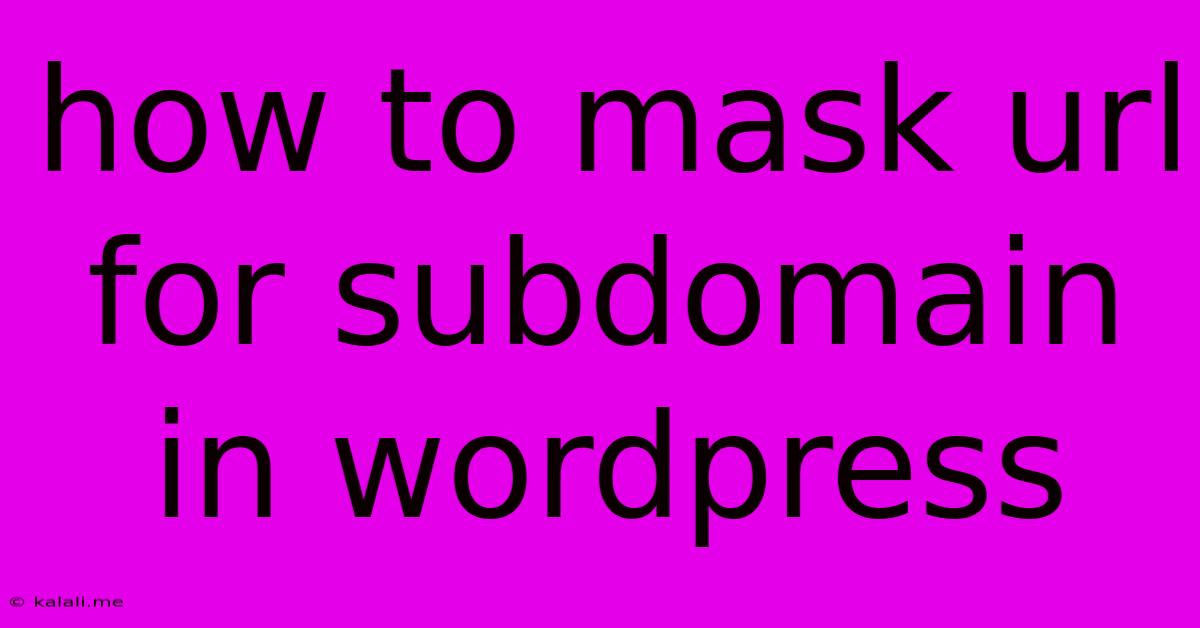How To Mask Url For Subdomain In Wordpress
Kalali
Jun 03, 2025 · 3 min read

Table of Contents
How to Mask URLs for Subdomains in WordPress: A Comprehensive Guide
Masking your subdomain URLs in WordPress can significantly improve your website's user experience and SEO. A masked URL hides the subdomain, presenting a cleaner and more professional web address to your visitors. This guide will walk you through several effective methods to achieve this, catering to different technical skill levels. This process enhances user experience by simplifying URLs, and from an SEO perspective, it can consolidate link equity and improve brand consistency.
Why Mask Subdomain URLs?
Before diving into the how-to, let's understand the why. Clean, concise URLs are crucial for several reasons:
- Improved User Experience: Shorter, more readable URLs are easier for users to remember, share, and type into their browsers. A masked URL like
example.com/blogis far more user-friendly thanblog.example.com. - Enhanced SEO: Search engines generally prefer clean, concise URLs. Masking can help consolidate link equity to your main domain, boosting your overall SEO performance.
- Brand Consistency: A consistent URL structure strengthens your brand identity and makes it easier for users to navigate your website.
Methods for Masking Subdomain URLs in WordPress
There are several ways to mask subdomain URLs, ranging from simple plugin solutions to more technical approaches. Here are a few popular options:
1. Using a WordPress Plugin: The Easiest Approach
Many WordPress plugins simplify the process of URL masking. These plugins often offer a user-friendly interface, making the process straightforward, even for beginners. Look for plugins specifically designed for URL redirection or rewriting. These plugins typically allow you to define redirects, mapping your subdomain URLs to their equivalent paths on your main domain.
Key Features to Look For:
- Easy-to-use interface: A simple and intuitive interface will save you time and frustration.
- 301 redirects: Ensure the plugin supports 301 (permanent) redirects. This is crucial for preserving SEO value when changing URLs.
- Bulk redirection: The ability to redirect multiple URLs simultaneously will be a time-saver if you have many subdomains or pages to redirect.
2. Utilizing .htaccess for Advanced Users: A Powerful but Technical Solution
For users comfortable with editing .htaccess files, this offers a highly customized approach. You can use .htaccess to create rewrite rules that redirect requests from your subdomain to the corresponding path on your main domain.
Caution: Incorrectly editing your .htaccess file can break your website. Always back up your file before making any changes. If you're not comfortable with this method, stick with a plugin. A sample .htaccess rule might look like this (adjust to your specific subdomain and path):
RewriteEngine On
RewriteCond %{HTTP_HOST} ^blog\.example\.com [NC]
RewriteRule ^(.*)$ https://example.com/blog/$1 [L,R=301]
This rule redirects all requests from blog.example.com to example.com/blog.
3. Leveraging WordPress's Built-in Redirection Features (Limited Functionality):
While not a dedicated masking solution, WordPress offers basic redirection capabilities through its admin panel. This can be sufficient for simple scenarios, but might not be suitable for complex setups with many subdomains. This method involves manually creating redirects for each URL you want to mask.
Choosing the Right Method
The best method depends on your technical skills and the complexity of your website. For most users, a well-designed WordPress plugin provides the easiest and safest approach. Advanced users comfortable with .htaccess can leverage its power for greater control and customization. Remember to always back up your website before making any significant changes.
By implementing one of these methods, you'll improve your site's SEO and user experience, paving the way for a more successful online presence. Remember that consistent and clear URLs are vital for both search engines and your audience.
Latest Posts
Latest Posts
-
How To Remove Handle From Bathroom Faucet
Jun 05, 2025
-
Bin Bash No Such File Or Directory
Jun 05, 2025
-
Keep Up A Ruse Vs Keep Up With A Ruse
Jun 05, 2025
-
Can Aluminum Pans Go In The Oven
Jun 05, 2025
-
Electrical Panel Neutral And Ground Bar
Jun 05, 2025
Related Post
Thank you for visiting our website which covers about How To Mask Url For Subdomain In Wordpress . We hope the information provided has been useful to you. Feel free to contact us if you have any questions or need further assistance. See you next time and don't miss to bookmark.